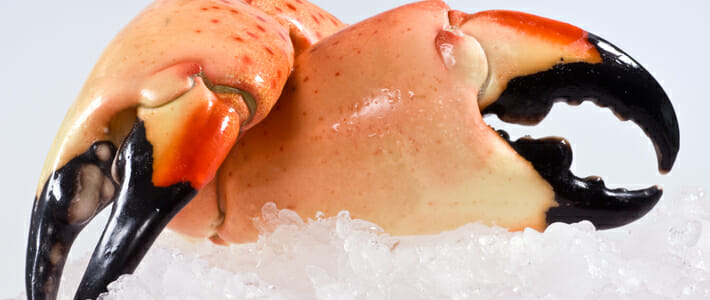Crab, Stone
Menippe mercenaria

Stone crabs are distinguished by their dark, brownish-red or tan shells, which are mottled gray when they are adults. This species has black-tipped claws, one larger than the other, and a smooth, shiny, round shell surface. Cooked meat is white.
Stone crabs have very little body meat; their only product form is the enormous claw with adjoining knuckles. Fishermen catch the crab, remove the claw then return the crab to the ocean so it can grow another. Most stone crab is sold fresh. Stone crabs are sold in 5 size categories: Medium (5-8 per pound); Large (3-5 per pound); Jumbo (2-3 per pound); Colossal (1-2 per pound); Super (1 per pound)
Product pdf for download-
3.5 oz (100g) raw edible portion
-
Calories 95
-
Calories from Fat 17
-
Total Fat 1.9g
-
Saturated Fat 0g
-
Cholesterol 78mg
-
Sodium 276mg
-
Total Carbohydrates 0g/0%
-
Protein 16.2g.
-
Potassium 279mg
Texture
The texture of stone crab is firm.
Quality Control
Stone crabs should be processed within three days of being caught. The claws should be boiled, chilled in an ice bath, and then boxed.
Preparation
Stone crabs are always sold pre-cooked. Simply thaw and chill for cold applications or heat gently for hot dishes.
Interesting Fact
The stone crab can sever its own claw at the first joint through muscular contraction in order to escape from danger.
Alternatives
Jonah and Mexican stone crabs can be used as substitutes for stone crab.
Source
Stone crabs are harvested from the Gulf of Mexico to the Carolinas, and most are caught in Florida.
Harvest Method
Stone crabs are harvested using traps/pots.
Harvest season
Stone crabs are harvested from mid-October to mid-May.
Flavor
This species has a mild and sweet flavor.
Market Segments
Stone crab is appropriate for fine dining, hotels, and resort/clubs.